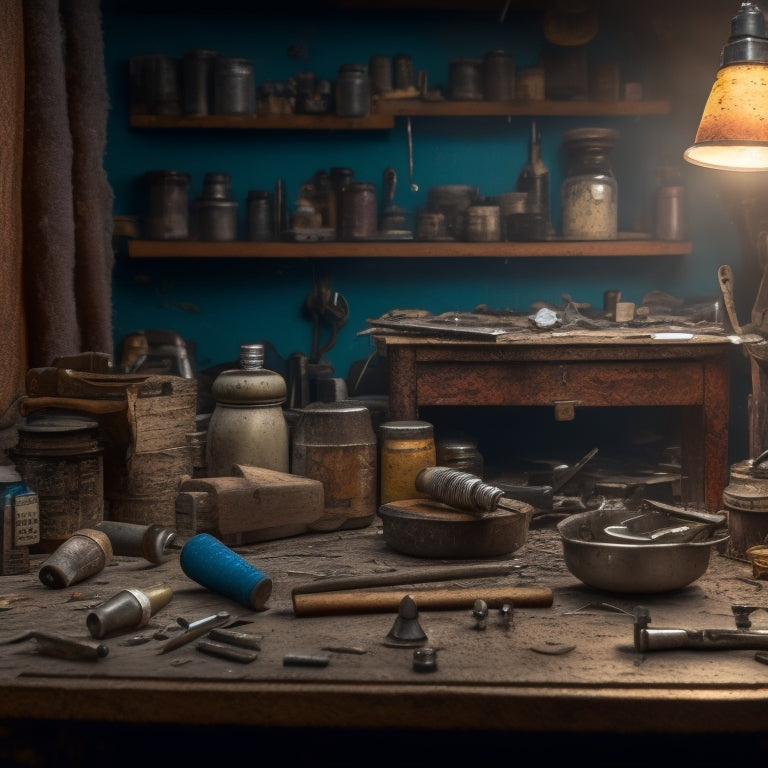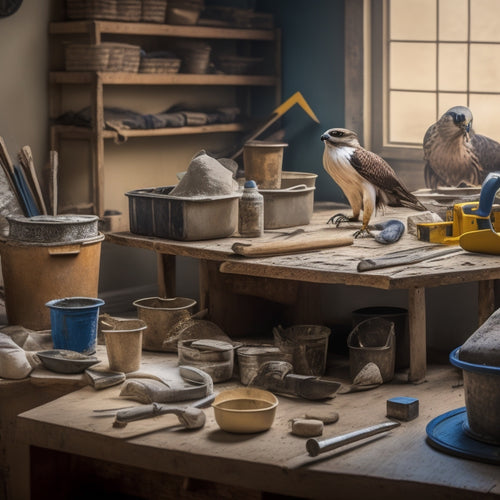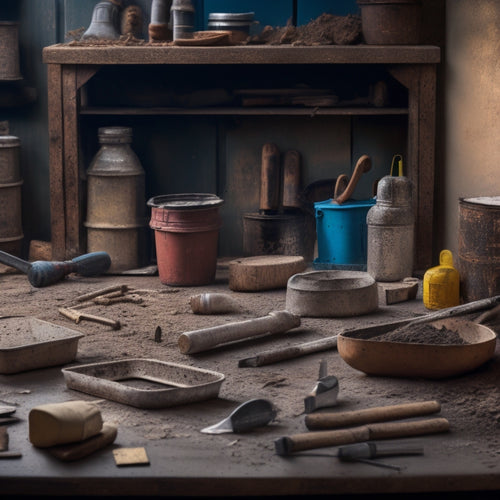
Why Safe Tool Selection Matters for Home Renovation
Share
When you commence a home renovation project, selecting the right concrete finishing tools is essential, as it directly impacts the quality of your results, your safety, and the longevity of your tools. You'll want to reflect on factors like the type of concrete, desired surface finish, and project scale to guarantee you're choosing the right tools for the job. Improper tool selection can lead to compromised surface quality, reduced tool lifespan, safety hazards, and poor performance. By understanding the importance of proper tool selection, you'll be better equipped to make informed decisions and take the necessary steps to protect yourself and achieve professional-looking results.
Key Takeaways
• Improper tool selection can lead to compromised surface quality, reduced tool lifespan, safety hazards, and subpar results like uneven finishes and cracks.
• Built-in safety features, ergonomic handle designs, and protective guarding systems are crucial for preventing accidents and reducing fatigue during tool use.
• Durable materials, protective coatings, and corrosion resistance ensure tool longevity and reduce the risk of failure, making them essential considerations for safe tool selection.
• Prioritizing quality over cost and assessing tool construction, materials, and performance capabilities can help mitigate potential hazards and ensure safe tool operation.
• Regular tool maintenance, inspection, and proper storage are necessary to prevent accidents, extend tool lifespan, and ensure optimal performance.
Understanding Concrete Finishing Tools
As you commence your home renovation project, selecting the right concrete finishing tools is essential to achieving a smooth, even surface that meets your design specifications.
You'll need to take into account various concrete finishing techniques, including tamping, edging, and floating, to determine the tools required for each stage.
When it comes to tool selection criteria, you'll want to evaluate factors such as the type of concrete, surface finish desired, and the scale of your project. For instance, a bull float is ideal for large, open areas, while a hand float is better suited for smaller, more intricate spaces.
You'll also need to take into account the level of vibration, weight, and ergonomic design when choosing tools to guarantee efficient and safe operation.
Additionally, assess the quality of the tools, including materials, construction, and durability, to ensure they can withstand the demands of your project.
Risks of Improper Tool Selection
Failing to select the right concrete finishing tools can lead to a multitude of problems, including compromised surface quality, reduced tool lifespan, and even safety hazards that put you and others at risk of injury.
When you choose the wrong tool, you're not only jeopardizing the success of your project, but also your own well-being. Incompatible tools can lead to poor performance, increased fatigue, and a frustrating user experience.
For instance, using a tool with the wrong blade type or size can cause it to overheat, vibrate excessively, or even break, leading to costly repairs or replacements.
Furthermore, improper tool selection can also lead to subpar results, such as uneven finishes, cracks, or discoloration.
As you take on your home renovation project, it's crucial to prioritize tool compatibility to guarantee a seamless and successful experience.
Safety Features to Look For
When selecting tools for your home renovation project, you'll want to prioritize those with built-in safety features that can prevent accidents and reduce the risk of injury.
You should look for tools with ergonomic handle designs that fit comfortably in your hand, reducing fatigue and improving control.
Additionally, you'll want to opt for tools with protective guarding systems that shield you from moving parts and other hazardous components.
Ergonomic Handle Design
Your grip on a tool's handle is a crucial interface that affects not only your comfort but also your control, making ergonomic handle design an essential safety feature to prioritize in your home renovation tool selection.
A well-designed handle provides ideal handle comfort, allowing you to work for extended periods without fatigue or discomfort. This, in turn, enhances grip stability, which is critical for maintaining control over the tool and preventing accidents.
When evaluating tools, look for handles with contoured shapes that fit snugly in your hand, providing a secure grip even in wet or slippery conditions. A non-slip grip material, such as rubber or textured plastic, can further improve handle comfort and grip stability.
Additionally, consider tools with adjustable handles that can be tailored to your hand size and preferences. By prioritizing ergonomic handle design, you can minimize the risk of accidents and injuries, ensuring a safer and more efficient home renovation experience.
Protective Guarding Systems
Its protective guarding system is a critical safety feature to scrutinize in your tool selection, as it serves as a barrier between you and the tool's moving parts, preventing accidental contact that can lead to serious injuries.
When evaluating a tool's protective guarding system, look for robust and durable protective barriers that can withstand the rigors of your renovation project. Verify the system meets or exceeds industry safety standards, such as those set by OSHA or ANSI.
A well-designed protective guarding system should provide a secure and reliable barrier between you and the tool's hazardous components, such as blades, cutters, or other moving parts.
Additionally, the system should be easy to install, maintain, and repair to minimize downtime and guarantee continuous operation.
Buying Concrete Finishing Tools Safely
When buying concrete finishing tools, you'll want to prioritize quality and assess potential risks to ascertain a safe and successful renovation.
You should consider the tool's construction, material, and performance capabilities to warrant it can withstand the demands of your project.
Tool Quality Considerations
You should prioritize tool quality over cost, as subpar concrete finishing tools can compromise the safety and integrity of your renovation project. When selecting tools, consider the tool lifespan and material durability to guarantee you're getting a product that will withstand the demands of your project. A high-quality tool may cost more upfront, but it will ultimately save you time and money in the long run by reducing the need for frequent replacements and minimizing the risk of accidents.
Look for tools made with durable materials that can withstand the rigors of concrete finishing. For example, a trowel with a high-carbon steel blade will last longer and perform better than one made with inferior materials.
Additionally, consider the ergonomic design of the tool and how it fits in your hand. A comfortable grip and balanced design will reduce fatigue and improve your overall performance.
Risk Assessment Essentials
Concrete finishing tool selection requires a thorough risk assessment to identify and mitigate potential hazards that can lead to accidents, injuries, or property damage during your home renovation project.
As you evaluate concrete finishing tools, you must consider the risks associated with each tool's design, functionality, and operation. Conduct a risk evaluation to identify potential hazards, such as electrical shock, cuts, or crush injuries. Assess the tool's ergonomic design, making certain it fits comfortably in your hand and reduces fatigue.
Next, perform hazard identification to determine the likelihood and potential impact of each hazard. Consider factors like tool maintenance, operator error, and environmental conditions.
Based on your risk evaluation and hazard identification, you can develop strategies to mitigate or eliminate these risks. This might involve selecting tools with built-in safety features, implementing proper training and operating procedures, or taking steps to guarantee a safe working environment.
Tool Material and Safety Implications
The choice of tool material can greatly impact the safety of your home renovation project, as certain materials are more prone to corrosion, wear, and tear, or even sparking, which can ignite flammable materials.
You'll want to select tools made from materials that offer high durability and resistance to corrosion. For instance, tools with stainless steel or titanium components can withstand harsh environments and reduce the risk of corrosion.
Additionally, consider tools with a protective coating or finish that can prevent rust and wear. A tool's material composition can also affect its lifespan. Tools made from high-quality materials will generally have a longer lifespan, reducing the need for frequent replacements and minimizing the risk of tool failure.
When evaluating tool materials, look for specifications that highlight material durability, such as rust-resistance or corrosion-proof ratings. By choosing tools with durable materials, you can guarantee a safer and more efficient renovation project.
Handle Design and Ergonomic Safety
Most handles are designed to fit comfortably in your hand, but a poorly designed handle can lead to fatigue, discomfort, and even accidents. As you work on your home renovation project, you'll likely be holding tools for extended periods, making handle design and ergonomic safety essential considerations.
A well-designed handle should provide a comfortable grip, allowing you to maintain control and precision. Here are three key factors to look for:
-
Contoured grip: A handle with a contoured grip will fit snugly in your hand, reducing slippage and strain.
-
Ergonomic shape: A handle shaped to match the natural curve of your hand will reduce fatigue and discomfort.
-
Non-slip material: A handle with a non-slip material, such as rubber or textured plastic, will provide a secure grip even in wet or oily conditions.
When selecting tools, prioritize handle comfort and grip. A comfortable handle will allow you to work more efficiently and safely, reducing the risk of accidents and injuries.
Protective Gear for Concrete Work
As you switch from handling tools to working with concrete, you'll need to prioritize protective gear to safeguard yourself from the unique hazards associated with concrete work. Concrete can be harsh on your skin and eyes, so it's vital to wear the right gear to prevent injuries.
First and foremost, you'll need protective gloves that can withstand the abrasive nature of concrete. Look for gloves made from durable materials like leather or synthetic fabrics that provide resistance to cuts, abrasions, and punctures. These gloves should also have a grip pattern on the palm to prevent slipping and dropping tools or materials.
In addition to gloves, safety goggles are a must-have for concrete work. Concrete dust and debris can easily get into your eyes, causing irritation or even serious injuries. Safety goggles with shatter-resistant lenses and a comfortable, secure fit will protect your eyes from these hazards.
Don't compromise on your safety – invest in high-quality protective gear to guarantee a safe and successful concrete working experience. By wearing the right gear, you'll be able to focus on the task at hand, confident that you're protected from the unique risks associated with concrete work.
Tool Maintenance and Inspection
You'll markedly extend the lifespan of your tools and prevent accidents by regularly inspecting and maintaining them, an essential step in ensuring your home renovation project stays on track. This involves more than just wiping down your tools with a rag; it requires a systematic approach to tool maintenance and inspection.
Here are three key steps to follow:
-
Tool cleaning: Regularly clean your tools to prevent the buildup of dirt, grime, and other substances that can affect their performance. Use the appropriate cleaning solutions and materials to avoid damaging your tools.
-
Tool inspection: Inspect your tools regularly for signs of wear and tear, damage, or malfunction. Check for loose parts, worn-out blades, and other issues that can impact tool performance.
-
Tool storage: Store your tools properly to prevent damage, rust, or corrosion. Use designated tool storage containers or cases, and keep them in a dry, protected area.
Manufacturer Guidelines and Certifications
When selecting tools for your home renovation project, consult the manufacturer's guidelines and certifications to confirm you're using products that meet industry standards for safety and performance. These guidelines provide essential information on tool usage, maintenance, and storage, guaranteeing you get the most out of your tools while minimizing risks.
Look for manufacturer certifications from reputable organizations, such as UL (Underwriters Laboratories) or ETL (Intertek), which verify compliance with safety standards. Compliance with these standards means the tools have undergone rigorous testing and meet specific requirements for electrical safety, durability, and performance.
Check the manufacturer's website or product packaging for certifications and guidelines specific to your tools. Confirm you understand the recommended usage and precautions for each tool to avoid accidents and injuries.
Frequently Asked Questions
Can I Use a Tool Beyond Its Recommended Expiration Date?
Can you use a tool beyond its recommended expiration date?
It's not recommended, as it compromises your safety and the tool's performance.
Tool longevity is essential, and exceeding the expiration date may lead to wear and tear, affecting its ability to meet safety standards.
You must consider the risks and potential consequences of using an outdated tool, as it may no longer provide the necessary protection or accuracy, putting you and your project at risk.
How Do I Dispose of Old or Damaged Concrete Finishing Tools?
When you're done with old or damaged concrete finishing tools, dispose of them responsibly.
You'll need to separate hazardous waste like oil-soaked rags or chemicals from recyclable tools.
Look for local tool recycling programs or facilities that accept construction waste.
Don't toss them in the trash, as they can contaminate landfills.
Instead, take them to designated drop-off points or schedule a special pickup.
Are Cordless Tools Safer Than Corded Tools for Concrete Work?
You're maneuvering a treacherous obstacle course, where one misstep can lead to disaster - that's what working with concrete can feel like.
When it comes to cordless vs corded tools, you'll find cordless options are safer, offering more control and flexibility.
They provide consistent tool performance, even in tight spaces, and often come equipped with advanced safety features, like overheat protection and battery cutoffs, giving you peace of mind on the job site.
Can I Modify a Tool to Make It More Ergonomic or Comfortable?
When modifying a tool for ergonomic enhancements, you'll want to guarantee the changes won't compromise its safety or performance.
Assess the tool's design and identify areas that cause discomfort or fatigue. You can add grips, padding, or ergonomic handles to reduce strain on your hands and wrists.
However, be cautious not to alter the tool's electrical or mechanical components, as this can void warranties or create hazards.
Always consult the manufacturer's guidelines before making any tool modifications.
Do I Need to Follow Manufacturer Guidelines for Tool Storage?
You're about to release a storm of productivity on your renovation project, but hold on - do you really know where your tools will sleep when the dust settles?
You need to follow manufacturer guidelines for tool storage, or risk damaging your investments. Proper tool organization and storage conditions are essential; ignoring them can lead to rust, corrosion, or even electrical damage.
Don't let your hard-earned cash go to waste - store your tools like a pro, and they'll reward you with years of faithful service.
Conclusion
As you finalize your home renovation plans, remember that safe tool selection is essential to avoiding injuries and ensuring a successful project.
You might think, 'But I'm only working on a small area, what's the worst that could happen?' However, even minor mistakes can have serious consequences.
By prioritizing tool safety, you'll not only protect yourself but also maintain the quality of your work.
Take the time to choose the right tools, and you'll be rewarded with a beautiful, hazard-free renovation.
Related Posts
-

Affordable Plastering Tools for Home Renovation Success
You're taking the first step towards a successful home renovation by investing in the right plastering tools. Start w...
-

Trowel Tool Cost for DIY Home Renovation Projects
When it comes to your DIY home renovation project, you'll need to budget for a variety of trowel tools, including stu...
-

Streamline Your Exterior Renovation Timeline
To streamline your exterior renovation timeline, you'll need to approach the process strategically. Start by planning...


